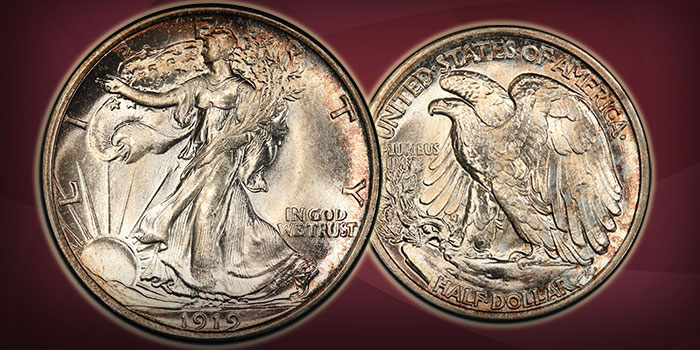
By CoinWeek ….
On Sunday, February 21, bidding ends at GreatCollections.com for this 1919 Walking Liberty Half Dollar, graded MS-66+ by PCGS and approved as strong for the grade by CAC.
A popular date from a popular series, 962,000 Walking Liberty half dollars were struck at Philadelphia in 1919. This makes it a less common coin to find than most other Walking Liberty halves (the ninth-lowest mintage, to be precise), but of course, a coin’s value isn’t determined by mintage alone. Indeed, that year’s Denver and San Francisco issues tend to be far more expensive even with mintages of 1.165 million and 1.552 million, respectively.
But the 1919 Walking Liberty is a condition rarity. The issue tends to come nice but high Mint State examples are truly rare. PCGS has graded just two specimens at the grade of MS-66+, with only four higher in MS-67 and one coin higher in the top pop grade of MS-67+. Reflecting this rarity, PCGS lists one auction record for an MS-66+ 1919 half dollar wherein a different example of the date sold for $21,600 USD in August 2019.
At the time of publication, the high bid for the 1919 Walking Liberty half dollar currently on offer from GreatCollections is $21,500 after 28 bids.
For more auction results, you can search through the GreatCollections Auction Archives, with records for over 600,000 certified coins the company has sold over the past seven years.
Background of the Walking Liberty Half Dollar
Charles Barber’s half dollar design was introduced in 1892, a beneficiary of the Mint Act of 1890, which allowed for the design of a coin to be changed every 25 years.
And likewise in 1916, Barber’s designs for the dime, quarter, and half dollar were also set aside–though unlike the smaller denominations, the half dollar of 1916 did not use Barber’s Liberty design. Mint Director Robert W. Woolley had invited three renowned sculptors from outside the Mint to produce designs for all three denominations, possibly intending that each coin would display the efforts of a different artist. However, German-born sculptor Adolph A. Weinman captured two of the three prizes, for the dime and the half dollar. Hermon A. MacNeil’s design was used for the quarter.
These new designs were representative of the artistic vigor of the early 20th century, following the previous changes to American coinage during that period (such as the Lincoln cent, the Indian Head (Buffalo) nickel, and of course the two Augustus Saint-Gaudens gold designs, among others).
Weinman’s designs were well-received at the time of release and are popular today, though there were technical issues. Many dates are weakly struck because areas of high relief on the design were opposite each other; weakness is often seen on Liberty’s left hand and leg and the eagle’s breast and leg feathers. In hopes of improving striking quality, engraver George T. Morgan made modifications in 1918 and 1921. These were followed by those of John R. Sinnock in the late 1930s, but neither produced significant improvements.
Liberty Walking halves, variously known as “Walkers” and Walking Liberty halves, were produced through 1947, replaced by John R. Sinnock’s Franklin design; Sinnock’s Roosevelt dime also replaced Weinman’s Mercury’ dime. While often assembled as a complete set, some collect only the “short sets” of either 1934 through 1947, or 1941 through 1947. Half dollars for circulation were not minted in 1922, 1924 through 1926, and 1930 through 1932.
Design
A full-length, striding figure of Liberty is displayed on the obverse, walking to the left. She wears a soft cap, Roman-style sandals with crossed ties, and a long flowing garment of alternating solid and vertically-striped panels. Her right arm is outstretched, reaching nearly to the flat rim of the coin, while her left holds a ‘bouquet’ of long oak and laurel (or olive) branches. Behind Liberty, and wrapped partially around her left arm, an American flag of stars and stripes billows, pushed forward by an implied wind at her back. At the bottom left is the sun with rays, partially obscured by a mountainous rise. The word LIBERTY surrounds a little more than the top half of the flat rim, the L overlapping a sun ray, and BER partially obscured by Liberty, the flag, and the branch leaves. To the right, near the bottom is IN GOD WE TRUST, the words on two lines, and the date is at the center of the bottom, below the level plain upon which Liberty walks.
On the reverse is a majestic standing eagle, wings partially uplifted, stands on a rock outcrop facing left, the right claw clutching a pine branch (showing both needles and cones) said to be symbolic of America. UNITED STATES OF AMERICA is placed near the flat rim above the eagle, and HALF DOLLAR is at the bottom. E PLURIBUS UNUM, UNUM on a separate line, is placed at the left-center just above the tips of the pine branch. Center dots separate adjacent words of the text phrases, with an additional dot following AMERICA. The designer’s initials AW, the A nested beneath the W, are at the bottom right, just to the right of the rocky perch. Mintmarks, when applicable, are located at the lower left, between the left of the edge of the rocky outcrop and the rim.
The edge is reeded.
A Rough Guide to the Walking Liberty Market
At the time of writing, prices are modest through MS63 for some issues prior to 1933, and for most dates post-1933 to MS65.
Higher-priced coins include most pre-1934 issues finer than MS60 – particularly the 1916-S, the 1917-D, and the 1917-S Obverse Mintmark, and most 1919 through 1921 examples. A few issues from 1934 and later that should also be included in this category are the 1934-S, the 1938-D, and the 1946 Doubled Die Obverse – the last two expensive as Gem and finer.





I have one dollar liberty 1919 In my collections